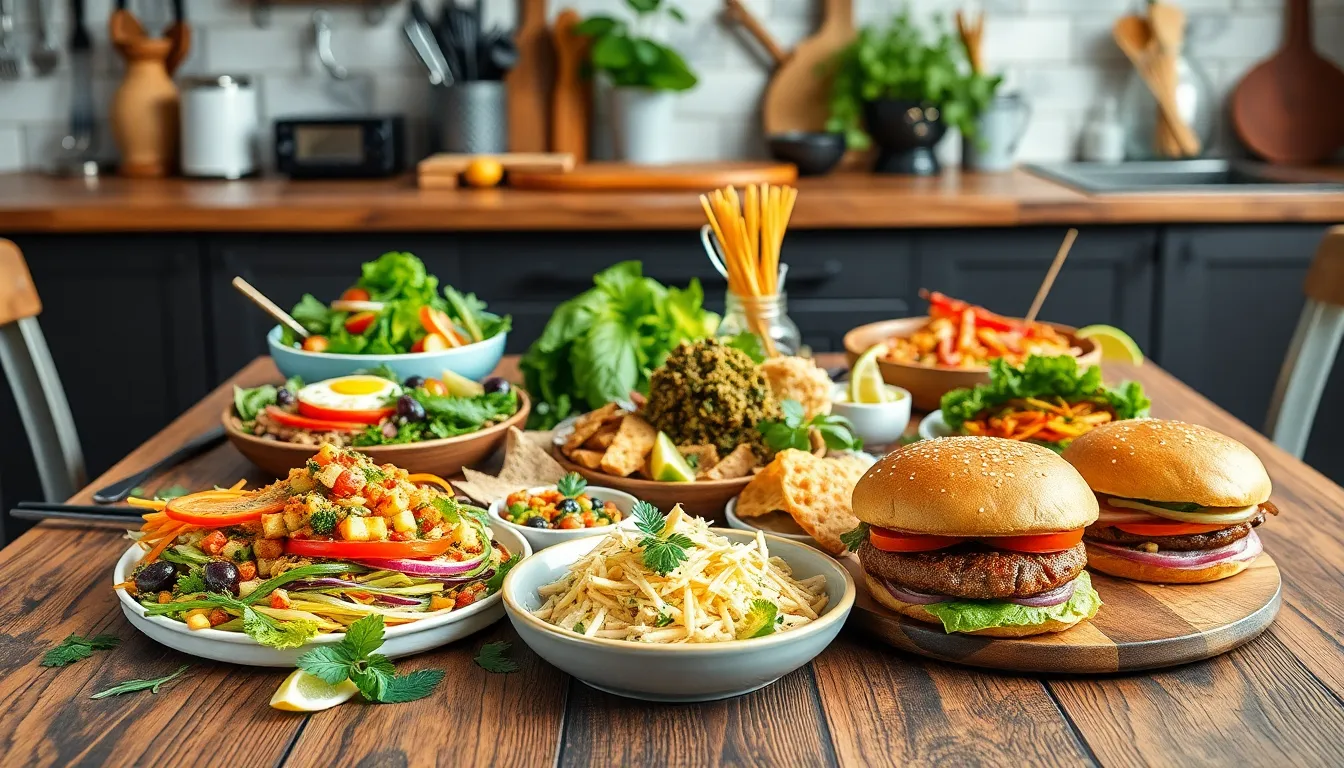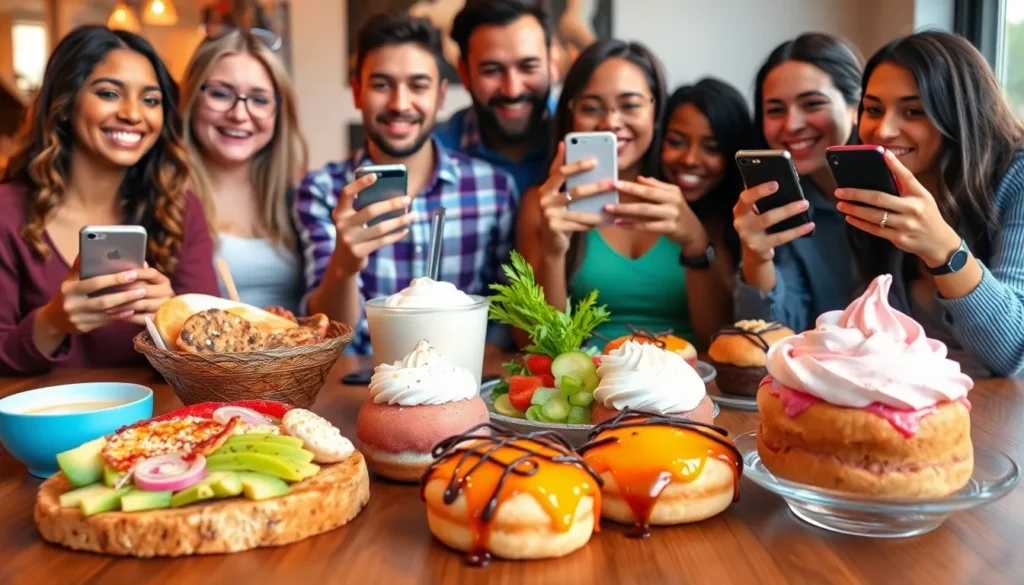In a world where avocado toast reigns supreme and whipped coffee has taken over breakfast tables, social media food trends are more than just fleeting fads—they’re a culinary revolution. Every scroll through Instagram or TikTok reveals a deliciously curated feast, sparking cravings that even the most disciplined dieters can’t ignore. From rainbow bagels to cloud bread, these edible eye-candies have transformed how people eat, cook, and share their culinary adventures.
But what’s behind these trends? It’s not just about the food; it’s about the experience. Social media has turned meals into masterpieces, encouraging creativity and connection. So grab your phone and get ready to dive into the colorful world of food trends that are not only pleasing to the palate but also to the ever-watchful eye of the camera. After all, if it’s not on social media, did it even really happen?
Social Media Food Trends
Social media significantly shapes contemporary food trends. Platforms such as Instagram and TikTok transform food into visually captivating experiences. Creatively presented dishes often attract attention through striking images and videos. Trends like avocado toast, sushi doughnuts, and whipped coffee exemplify this phenomenon. They represent more than just culinary fads; they showcase a cultural evolution in dining habits.
Visual appeal now drives choices in food preparation and consumption. Many users prioritize aesthetics, curating feeds filled with colorful dishes. This focus encourages restaurants and home cooks to innovate and experiment. Engaging content often features vibrant ingredients, unusual flavor combinations, or artistic plating techniques. Hashtags play a crucial role in popularizing these food items; trending hashtags connect users with similar interests.
Community engagement fuels the rise of food trends on social platforms. Influencers and everyday users alike share recipes, reviews, and cooking tips. This exchange fosters a sense of belonging among food enthusiasts. Viral challenges, such as the #EatTheRainbow challenge, promote healthier choices through fun participation. Food trends thus become communal experiences, uniting people around shared interests.
Analytics demonstrate the influence of social media on food preferences. A study from NCSolutions found that 60% of consumers discovered new recipes on social media. Food brands leverage this insight, investing in attractive imagery and engaging narratives. Increased engagement translates into higher sales and brand loyalty.
Overall, social media drives constant evolution in food culture, transforming dining into an aesthetic journey. Visual storytelling enriches the way people share and discover food, reinforcing connections to culinary experiences.
Popular Trends in 2023

In 2023, food trends reflect evolving culinary preferences, heavily influenced by social media. Platforms like TikTok and Instagram continue to drive innovation and connection among food enthusiasts.
Plant-Based Diets
Plant-based diets gain popularity as health-focused consumers seek sustainable options. Research shows that 39% of U.S. adults actively reduce meat consumption. Vegan and vegetarian dishes dominate social media feeds, showcasing colorful ingredients and enticing presentations. Many influencers emphasize plant-based meals that are both delicious and visually appealing. Various recipes highlight the variety within this diet, ranging from vibrant salads to hearty veggie burgers.
Visual Aesthetics in Food
Visual aesthetics play a crucial role in attracting food lovers. Engaging images of dishes encourage sharing and interaction. Studies indicate that visually appealing meals generate 60% more engagement on platforms like Instagram. Striking colors and creative plating in dishes like rainbow poke bowls captivate audiences. Home cooks often showcase their creations, replicating restaurant-quality aesthetics with simple techniques. This emphasis on presentation extends beyond the plate, influencing food packaging and marketing strategies.
Global Culinary Influences
Global culinary influences diversify the food landscape in 2023. Growing interest in international cuisines inspires chefs and home cooks alike. Dishes from cultures such as Korean, Mexican, and Mediterranean frequently appear in trending feeds. Fusion recipes blend traditional and contemporary flavors, creating excitement for adventurous eaters. Social media facilitates cross-cultural exchanges, allowing people to explore and celebrate global food traditions. As a result, many food brands incorporate global elements into their menus, attracting a wider audience.
Impact of Social Media on Food Culture
Social media significantly shapes food culture, influencing both user behavior and food trends.
User-Generated Content
User-generated content plays a pivotal role in promoting food trends. Individuals share their culinary creations across platforms, showcasing meals and recipes. Engaging photos of dishes entice followers, leading to increased visibility for unique food items. Food enthusiasts, including home cooks, participate in sharing vibrant, accessible meals. Community-driven content fosters connectivity, as people bond over shared tastes and experiences. When users exchange ideas, they spark creativity, inspiring others to explore new dishes. Analytics highlight that many consumers discover recipes through social media engagement, indicating a shift towards user-driven culinary exploration.
Influencer Marketing
Influencer marketing drives food trends through strategic partnerships. Influencers share curated content featuring restaurants, recipes, and food brands. Their substantial following enables them to sway audience preferences significantly. Authentic endorsements from trusted figures enhance product visibility, translating to more significant interest in different cuisines. The 2023 data reveals that visually striking meals generate 60% more engagement, further motivating brands to collaborate with influencers. Partnerships often involve challenges and campaigns, enhancing community participation. Successful promotions frequently create viral moments that elevate specific dishes and ingredients, illustrating influencer marketing’s impact on food culture.
Challenges and Criticisms
Social media food trends face several challenges and criticisms that warrant attention.
Sustainability Issues
Sustainability remains a significant concern in the realm of food trends. The popularity of visually stunning items often leads to overconsumption and food waste. Approximately 40% of food in the U.S. goes uneaten, indicating a pressing issue. Plants also require extensive resources, and the surge in plant-based diets can complicate agricultural demands. Brands showcasing exotic ingredients may encourage unsustainable farming practices or contribute to biodiversity loss. As consumers seek more eco-friendly options, awareness around sourcing and environmental impact becomes crucial.
Misinformation in Trends
Misinformation frequently circulates alongside viral food trends. A rise in exaggerated health claims around certain ingredients can mislead consumers. Many trends lack scientific backing, potentially leading to poor dietary choices. For instance, the “detox” claims surrounding some popular diets often contradict established nutritional guidelines. Social media platforms’ rapid spread of information can create confusion, resulting in misguided attempts at healthy eating. Verification of facts and reliable sources plays an integral role in promoting healthy food culture.
Conclusion
Social media’s influence on food trends is undeniable. It’s reshaped how individuals view cooking and dining, turning meals into artistic expressions. The vibrant dishes shared online not only inspire creativity but also foster a sense of community among food lovers.
As culinary preferences evolve, the focus on aesthetics and innovation continues to drive engagement. While the excitement around these trends is palpable, it’s crucial to remain aware of the challenges they bring. Sustainability and misinformation are pressing issues that require attention.
Navigating this colorful food landscape means embracing creativity while also being mindful of the impact on health and the environment. Social media will undoubtedly keep shaping food culture, making it essential for enthusiasts to stay informed and engaged.
